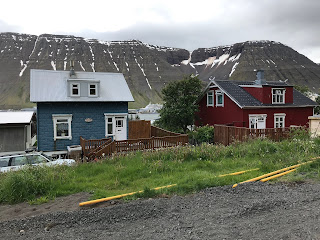The Thingvellir
plain is a geological marvel. Southwest of Reyjkavik, it is where the American
and Eurasian tectonic plates meet, and, geologically you can walk from Europe
to America in a matter of minutes.
It is also the
birthplace of Icelandic democracy. The Althing was founded here as an open air
assembly in 930 AD and is the oldest continuous parliament in the world. Held
in what is now part of the Thingvellir National Park, all the most important
men of the island gathered to meet, change and make laws. All free men were
allowed to attend, and the assembly continued to meet even after Iceland was
annexed by Norway in the C13th. Only when Denmark took over was its power
significantly reduced, but even then the Althing continued to surprise – giving
women the vote in 1915.
It perhaps makes
up for what I termed the ‘murder pool’ a stone’s throw from the Althing, and
where justice was summarily meted out on – primarily on women. There they were
drowned.
The white house
is, coincidentally, the holiday home of Iceland’s Prime Minister. A story,
perhaps apocryphal, involves an American tourist exploring the church and the
house and accosting a stranger for information about the two buildings. On
being told it was the Prime Minister’s private residence he was surprised,
telling the Icelander that in America, the President’s private residence would
have been well guarded with no tourists allowed anywhere near it. As they said their
goodbyes the tourist introduced himself, as did the Icelander. ‘I’m the Prime
Minister,’ he said.
Next to the
house is Thingvellir Church built in the C10th but destroyed by a great storm
in 1118. This present church was built in 1859 and had three bells, the
original ancient bell, a bell from 1968 and the 1944 bell installed when
Iceland got its independence from Denmark.
The circular green to one side of the church,
is the National Cemetery of Iceland holding just two graves. The first grave is
that of Einar Benediktsson, a C20th nationalist and poet. There followed a
period of headscratching when it transpired that nobody else wanted to be
buried in the middle of nowhere. Then they decided they would dig up the body
of an even old poet Jonas Hallgrimsson who died in Denmark in 1845. Such a
great Icelandic poet must surely be buried in Iceland! Unfortunately it is
likely that they exhumed and transported the wrong body – that of a Danish
baker. So, poet and baker lie side by side in the National Cemetery of Iceland.
When you see for yourself the bleakness, and imagine it at night or in mist, it's easy to imagine an alternative world.
The Huldrefolk or hidden folk
are the Icelandic equivalent of elves seen by few but believed in by many. One
story traces their origins to Adam and Eve, and yet again blames the woman. Eve was
washing her four children. Two were clean, two were not when God came a
calling. Ashamed of showing her two dirty children, Eve hid them from God’s
sight. To prove a point, perhaps, though God knows what, the Good Lord decreed
that henceforth these two children and their descendants should be hidden from
man. A variant of the story explains how the Elves were neutral in the great
conflict between Lucifer and God. Lucifer was bound to Hell, the Elves were
punished by being hidden from man. One thing for sure, those stones associated
with the Hidden Folk are treated with huge respect, to the extent that roads
are narrowed or skirt around them.
Volcanic gorges like these resemble roughly hewn castles, perhaps built by Trolls.
Trolls were or are, man-eaters, slow and dull-witted, but on occasions,
surprisingly helpful and loyal to those who come to their aid. Their big
problem is sunlight, which turns them to rock.
And of course there are geysers and waterfalls. Lots of waterfalls
Gulfoss (Golden Falls)
















































